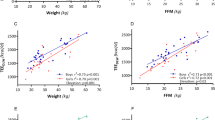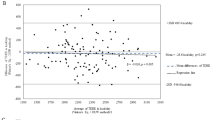Abstract
Background/Objectives
Young Indian adults are at greater risk of overweight/obesity due to their high energy intake and sedentary lifestyle. Their energy requirement (ER) is based on their total energy expenditure (TEE) estimated from factorial method, which possibly overestimates their basal metabolic rate (BMR) and physical activity level (PAL). This study aimed to compare the accurately measured TEE with ER in young adults. Secondarily, to compare measured with predicted BMR and guideline PAL with that obtained from questionnaire and step counts.
Subjects/Methods
TEE was measured in 19 male adults (18–30 years), using the doubly labeled water technique, over 14 days. Indirect calorimetry was used to measure BMR, while the PAL was estimated by (a) the ratio of measured TEE and BMR, (b) step counts over 7 days measured using tri-axial accelerometers and (c) a physical activity questionnaire (PAQ).
Results
The measured TEE (9.11 ± 1.30 MJ/d) was significantly lower than the ER using either the Indian (15.2%) or the FAO/WHO/UNU (11.9%, both p < 0.01) recommendations. The measured BMR (6.90 ± 0.65 MJ/d) was significantly lower than that predicted using the FAO/WHO/UNU equation (6.5%, p < 0.01) but not for the Indian equation. The estimated PAL from measured TEE and BMR (1.35 ± 0.18), and from accelerometers (1.33 ± 0.11) was significantly lower than PAL obtained from PAQ (1.53 ± 0.17) or the guideline of 1.53 for Indians.
Conclusions
The predicted BMR and PAL guideline value was higher than that measured in young Indian adults, resulting in a ~13% lower measured TEE. This emphasizes the need to revisit the guidelines for predicting ER for this population.
This is a preview of subscription content, access via your institution
Access options
Subscribe to this journal
Receive 12 print issues and online access
$259.00 per year
only $21.58 per issue
Buy this article
- Purchase on Springer Link
- Instant access to full article PDF
Prices may be subject to local taxes which are calculated during checkout

Similar content being viewed by others
References
International Institute of Population Science. National Family Health Survey India 2015–2016: India fact sheet. Mumbai: Ministry of Health and Family Welfare. Government of India; 2016. http://rchiips.org/NFHS/pdf/NFHS4/India.pdf. Accessed 4 May 2020.
World Bank. World Development Indicators: Data Bank. https://databank.worldbank.org/reports.aspx?source=2&series=SP.POP.2529.MA.5Y&country=#. Accessed 4 May 2020.
Office of Registrar General & Census Commissioner. Census of India: Age structure and marital status. Ministry of Home Affairs, Government of India, 2011. https://censusindia.gov.in/Census_And_You/age_structure_and_marital_status.aspx. Accessed 4 May 2020.
Tripathy JP, Thakur JS, Jeet G, Chawla S, Jain S, Prasad R. Urban rural differences in diet, physical activity and obesity in India: are we witnessing the great Indian equalisation? Results from a cross-sectional STEPS survey. BMC Public Health. 2016;16:1–10.
Arora S, Nanda K. What’s cooking with Indian Diners: understanding eating-out patterns among Indian consumers. Nielsen Featured Insights, India, 2017.
KPMG. India’s food service industry: growth recipe. Federation of Indian Chambers of Commerce and Industry (FICCI), 2016. https://assets.kpmg/content/dam/kpmg/in/pdf/2016/11/Indias-food-service.pdf. Accessed 6 May 2020.
Roberts SB, Das SK, Suen VMM, Pihlajamäki J, Kuriyan R, Steiner-Asiedu M, et al. Measured energy content of frequently purchased restaurant meals: multi-country cross sectional study. BMJ. 2018;363:1–10.
Cuthbertson DJ, Steele T, Wilding JP, Halford JC, Harrold JA, Hamer M, et al. What have human experimental overfeeding studies taught us about adipose tissue expansion and susceptibility to obesity and metabolic complications? Int J Obes. 2017;41:853–65.
FAO/WHO/UNU. Energy and protein requirements. Report of a joint FAO/WHO/UNU Expert Consultation Technical Report Series 724. FAO/WHO/UNU; Vol. 27, Geneva, 1985.
Bluck L, Forsum L, Hills A, Kurpad A, Mokhtar N, Preston T, et al. editors. Assessment of body composition and total energy expenditure in humans using stable isotope technique. IAEA Human Health Series No. 3. Vienna: IAEA; 2009.
FAO/WHO/UNU. Human energy requirements. Report of a Joint FAO/WHO/UNU Expert Consultation. FAO/WHO/UNU; Rome, 2004.
Indian Council of Medical Research. Nutrient requirements and recommended dietary allowances for Indians. A report of the expert group of the Indian Council of Medical Research National Institute of Nutrition Hyderabad. Indian Council of Medical Research; Hyderabad, 2010.
Henry C. Basal metabolic rate studies in humans: measurement and development of new equations. Public Health Nutr. 2005;8:1133–52.
Deurenberg P, Deurenberg-Yap M, Guricci S. Asians are different from Caucasians and from each other in their body mass index/body fat per cent relationship. Obes Rev. 2002;3:141–6.
Hood K, Ashcraft J, Watts K, Hong S, Choi W, Heymsfield SB, et al. Allometric scaling of weight to height and resulting body mass index thresholds in two Asian populations. Nutr Diabetes. 2019;9:1–7.
Miyake RM, Tanaka ST, Ohkawara K. Validity of predictive equations for basal metabolic rate in Japanese adults. J Nutr Sci Vitaminol. 2011;57:224–32.
Razalee S, Poh BK, Ismail MN. Predictive equation for estimating the basal metabolic rate of Malaysian Armed Forces naval trainees. Singap Med J. 2010;51:635–40.
Shetty PS, Soares MJ, Sheela ML. Basal metabolic rate of South Indian males. FAO Report. Bangalore, India, 1986.
Soares M, Shetty P. Validity of Schofield’s predictive equations for basal metabolic rates of Indians. Indian J Med Res. 1988;88:253–60.
Soares MJ, Francis DG, Shetty PS. Predictive equations for basal metabolic rates of Indian males. Eur J Clin Nutr. 1993;47:389–94.
Anjana RM, Pradeepa R, Das AK, Deepa M, Bhansali A, Joshi SR, et al. Physical activity and inactivity patterns in India – results from the ICMR-INDIAB study. Int J Behav Nutr Phys Act. 2014;11:1–11.
Althoff T, Sosič R, Hicks JL, King AC, Delp SL, Leskovec J. Large-scale physical activity data reveal worldwide activity inequality. Nature. 2017;547:336–9.
Bharthi A, Sandhya N, Vaz M. The development and characteristics of a physical activity questionnaire for epidemiological studies in urban middle class Indians. Indian J Med Res. 2000;111:95–102.
Weir JBD. New methods for calculating metabolic rate with special reference to protein metabolism. J Physiol. 1949;109:1–9.
Racette SB, Schoeller DA, Luke AH, Shay K, Hnilicka J, Kushner RF. Relative dilution spaces of 2H- and 18O-labeled water in humans. Am J Physiol - Endocrinol Metab. 1994;267:30–34.
Scholeller D Hydrometry. In: Roche A, Heymsfield S, Lohman T editors. Human body composition. 1st ed. Champaign, IL: Human Kinetics; 1996. pp. 25–43.
Kurpad A, Borgonha S, Shetty P. Measurement of total energy expenditure by the doubly labelled water technique in free living Indians in Bangalore city. Indian J Med Res. 1997;105:212–9.
Borgonha S, Shetty PS, Kurpad AV. Total energy expenditure & physical activity level in chronically energy deficient Indian males measured by the doubly labelled water technique. Indian J Med Res. 2000;111:138–46.
Raj T, D’Souza G, Elia M, Kurpad AV. Measurement of 24 h energy expenditure in male tuberculosis patients. Indian J Med Res. 2006;124:665–76.
Tudor-Locke C, Martin CK, Brashear MM, Rood JC, Katzmarzyk PT, Johnson WD. Predicting doubly labeled water energy expenditure from ambulatory activity. Appl Physiol Nutr Metab. 2012;37:1091–100.
Whybrow S, Hughes DA, Ritz P, Johnstone AM, Horgan GW, King N, et al. The effect of an incremental increase in exercise on appetite, eating behaviour and energy balance in lean men and women feeding. Br J Nutr. 2008;100:1109–15.
Willis EA, Herrmann S, Homas J, Lee J, Donnelly J, Washburn R. Nonexercise energy expenditure and physical activity in the Midwest Exercise Trial. Med Sci Sport Exerc. 2014;46:2286–94.
Sasai H, Nakata Y, Murakami H, Kawakami R, Nakae S, Tanaka S, et al. Simultaneous validation of seven physical activity questionnaires used in japanese cohorts for estimating energy expenditure: a doubly labeled water study. J Epidemiol. 2018;28:437–42.
Yajnik CS, Yudkin JS. The YY paradox. Lancet. 2004;363:163.
Black A, Coward W, Cole T, Prentice A. Human energy expenditure in affluent societies: an analysis of 574 doubly-labelled water measurements. Eur J Clin Nutr. 1996;50:72–92.
Guthold R, Stevens GA, Riley LM, Bull FC. Worldwide trends in insufficient physical activity from 2001 to 2016: a pooled analysis of 358 population-based surveys with 1.9 million participants. Lancet Glob Heal. 2018;6:e1077–e1086.
Swaminathan S, Sinha S, Minocha S, Makkar S, Kurpad AV. Are we eating too much? A critical reappraisal of the energy requirement in Indians. Proc Indian Natl Sci Acad USA. 2018;84:809–19.
Ranasinghe C, Ranasinghe P, Jayawardena R, Misra A. Physical activity patterns among South-Asian adults: a systematic review. Int J Behav Nutr Phys Act. 2013;10:1–11.
Sabounchi NS, Rahmandad H, Ammerman A. Best-fitting prediction equations for basal metabolic rate: informing obesity interventions in diverse populations. Int J Obes. 2013;37:1364–70.
Sharp TA, Bell ML, Grunwald GK, Schmitz KH, Sidney S, Lewis CE, et al. Differences in resting metabolic rate between White and African-American young adults. Obes Res. 2002;10:726–32.
Speakman JR, Pontzer H, Rood J, Sagayama H, Schoeller DA, Westerterp KR, et al. The International Atomic Energy Agency international doubly labelled water database: aims, scope and procedures. Ann Nutr Metab. 2019;75:114–8.
Acknowledgements
The guidance of Dr. S Devi in interpreting the DLW data for estimating TEE and body composition is acknowledged. The authors would also like to acknowledge the voluntary participation of the participants in the study, the technicians and the lab personnel in sample processing and analysis.
Funding
This research study had received funding from Indian Council of Medical Research (ICMR) in the year 2019 (Grant sanction order 5/9/1200/2019-Nut to RK and AVK).
Author information
Authors and Affiliations
Contributions
AVK and RK conceptualized the study. SS was involved in participant screening, data collection and data cleaning. SS, AVK, and RK were involved in statistical analysis of the data. The draft manuscript was prepared by SS and RK while the final approval was provided by AVK. All authors have read and approved the manuscript.
Corresponding author
Ethics declarations
Conflict of interest
The authors declare that they have no conflict of interest.
Additional information
Publisher’s note Springer Nature remains neutral with regard to jurisdictional claims in published maps and institutional affiliations.
Rights and permissions
About this article
Cite this article
Sinha, S., Kurpad, A.V. & Kuriyan, R. Total energy expenditure (TEE) of young adults from urban South India: revisiting their daily energy requirement. Eur J Clin Nutr 75, 845–851 (2021). https://doi.org/10.1038/s41430-020-00790-5
Received:
Revised:
Accepted:
Published:
Issue Date:
DOI: https://doi.org/10.1038/s41430-020-00790-5



